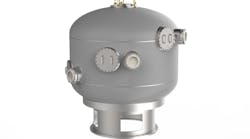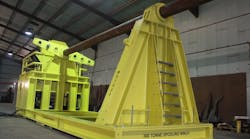Editor's note: This Offshore Wind Energy section first appeared in the November-December 2022 issue of Offshore magazine.
By Bruce Beaubouef, Houston
Offshore wind energy developers are increasingly looking to solar technologies to bolster and enhance the reliability of their renewable energy projects. The basic idea is that the technologies are complementary: while solar power peaks during the day, offshore wind turbines typically generate most of their power in the afternoon and evening. Employing both, it is argued, can lead to a more reliable and more balanced power production profile.
Vendors of floating solar energy systems say that they can be installed safely in between existing offshore wind turbines and can be constructed anywhere with pop-up assembly lines.
In addition, it is argued that integrating floating solar technology into an offshore wind farm allows for a more efficient use of ocean space for energy generation; and that floating solar technology can also provide an answer to increasing land scarcity for the generation of renewable energy.
The first notable offshore combined solar/wind energy system was commissioned in early November, offshore China. That was when China’s state-owned utility State Power Investment Corporation (SPIC) launched the world’s first commercial floating solar system paired with an offshore wind turbine. The pilot project is located off the coast of Haiyang, a city in Shandong, in eastern China.
SPIC is one of five major electrical utility companies in China, and is said to be the world’s largest photovoltaic power generation enterprise. The project is designed to tap into the potential of hybrid offshore power plants by lowering the levelized cost of energy, the benchmark ratio of lifetime expenses and energy output.
The pilot project uses Norway-based Ocean Sun’s patented floating solar power technology, and is said to be Ocean Sun’s first “truly offshore installation.” The two solar energy floaters, with a peak capacity of 0.5 MW, are connected to the transformer on an SPIC-owned wind turbine, which is in turn linked to a submarine cable that sends the electricity to an onshore power grid. If the pilot project is successful, the plan is to build a 20 MW floating wind-solar farm in 2023 using Ocean Sun’s technology.
Meanwhile, another hybrid power pilot project is taking shape offshore Europe. This past summer, Germany’s RWE and the Dutch-Norwegian company SolarDuck signed an agreement to develop the use of floating solar parks at sea. SolarDuck says that its triangular-shaped platform, which has received the world’s first certification for offshore floating solar by Bureau Veritas, is designed to float several meters above the water, following the waves like a carpet. This design, the company says, keeps critical electrical components dry, clean, and stable as well as secures the integrity of the semisubmersible structure while enabling safe operations and minimal maintenance.
To accelerate the development of the technology, RWE says it will invest in SolarDuck’s full-scale offshore pilot called Merganser, which is expected to have a nameplate capacity of 0.5 MWp.
Merganser is expected to be installed off the coast of Ostend in the Belgian North Sea in 2023, and will be SolarDuck’s first offshore pilot, following the successful deployment of an inland pilot in the Netherlands last year. The companies say that the Merganser project will provide them with important first-hand experience, and these learnings will enable a faster commercialization of the technology from 2023 onward.
The companies also said that the Merganser project lays the foundation for a larger demonstration project at the Dutch offshore wind farm Hollandse Kust West. RWE is tendering for this project and has included SolarDuck into its bid with a combination of offshore floating solar technologies with the latest integrated storage solutions.
In November, the Dutch Offshore Floating Solar (OFS) consortium behind the Merganser project received a grant of EUR7.8 million ($8 billion) from RVO (Netherlands Enterprise Agency) to develop, test, and validate the solar energy platform concept in harsh North Sea conditions. SolarDuck, a member of the OFS consortium, says it will collaborate with research institutes TU Delft, TNO, MARIN and Deltares, with six interconnected OFS platforms in the pilot delivering 500 KWp.
The institutes’ research scope will include corrosion resistance of the solar and electrical systems, UV degradation of the synthetic anchors, and marine growth on the floaters.
Other issues to be investigated are the potential integration of offshore solar and wind energy systems; developing fatigue prediction models; and developing flexible mooring line concepts for shallow-water projects. Testing and monitoring should be completed by year-end 2024.





